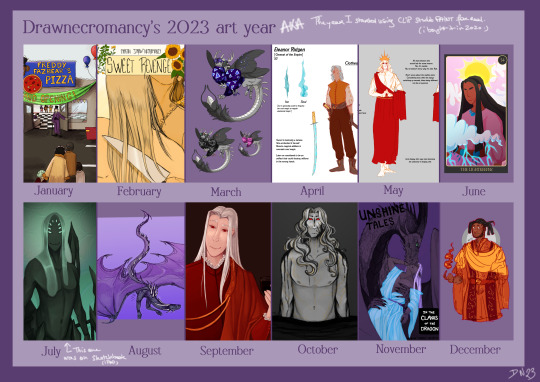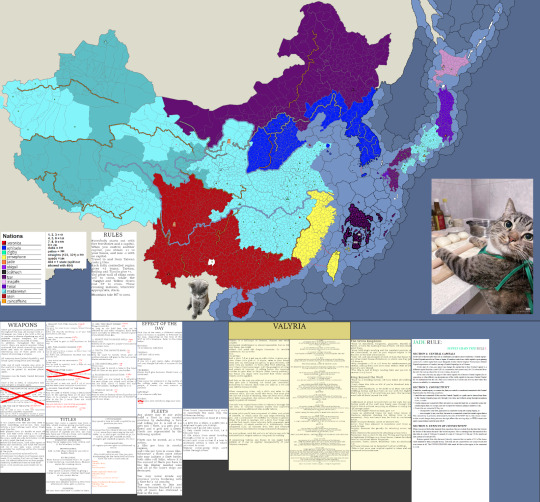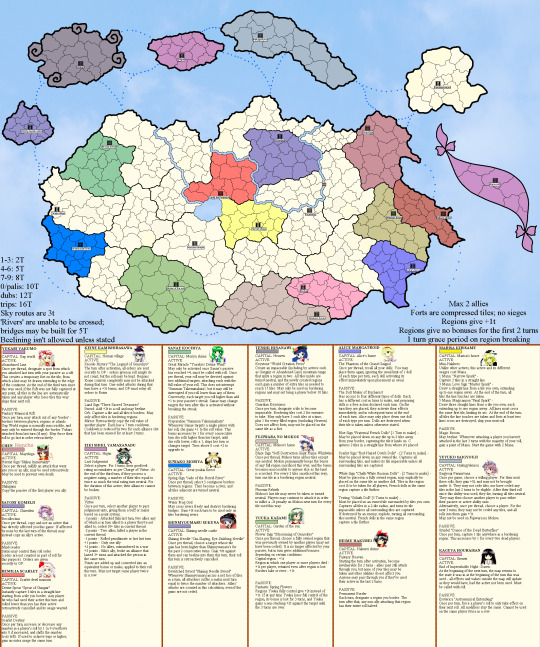#Digital Issue - June 2023
Explore tagged Tumblr posts
Text

New Year's in two days, so why not subject you all to my inability to stay on topic ? I keep changing what I'm working on every month. It's fun :)
I don't think I ever released those Aether skins on Flight Rising. They're just living in my hard drive. Eating all the paper
#2023 art recap#2023 art#my art#art#digital art#uhhh yeah tags whatever#the June one is a comm for logarithmicpanda!#i wanted to include more of that art style but i literally haven't done any that wasn't commissions#and then i realized that in June this was one of the ONLY TWO artworks i finished#because i was busy with SO MANY THINGS in real life#the only other things i did in june were sketches#some of my darlings aren't there due to cropping issues#rip the big painting from july that took 23 hours to make! the sexy spider was easier to fit in
6 notes
·
View notes
Text
average United States contains 1000s of pet tigers in backyards" factoid actualy [sic] just statistical error. average person has 0 tigers on property. Activist Georg, who lives the U.S. Capitol & makes up over 10,000 each day, has purposefully been spreading disinformation adn [sic] should not have been counted
I have a big mad today, folks. It's a really frustrating one, because years worth of work has been validated... but the reason for that fucking sucks.
For almost a decade, I've been trying to fact-check the claim that there "are 10,000 to 20,000 pet tigers/big cats in backyards in the United States." I talked to zoo, sanctuary, and private cat people; I looked at legislation, regulation, attack/death/escape incident rates; I read everything I could get my hands on. None of it made sense. None of it lined up. I couldn't find data supporting anything like the population of pet cats being alleged to exist. Some of you might remember the series I published on those findings from 2018 or so under the hashtag #CrouchingTigerHiddenData. I've continued to work on it in the six years since, including publishing a peer reviewed study that counted all the non-pet big cats in the US (because even though they're regulated, apparently nobody bothered to keep track of those either).
I spent years of my life obsessing over that statistic because it was being used to push for new federal legislation that, while well intentioned, contained language that would, and has, created real problems for ethical facilities that have big cats. I wrote a comprehensive - 35 page! - analysis of the issues with the then-current version of the Big Cat Public Safety Act in 2020. When the bill was first introduced to Congress in 2013, a lot of groups promoted it by fear mongering: there's so many pet tigers! they could be hidden around every corner! they could escape and attack you! they could come out of nowhere and eat your children!! Tiger King exposed the masses to the idea of "thousands of abused backyard big cats": as a result the messaging around the bill shifted to being welfare-focused, and the law passed in 2022.
The Big Cat Public Safety Act created a registry, and anyone who owned a private cat and wanted to keep it had to join. If they did, they could keep the animal until it passed, as long as they followed certain strictures (no getting more, no public contact, etc). Don’t register and get caught? Cat is seized and major punishment for you. Registering is therefore highly incentivized. That registry closed in June of 2023, and you can now get that registration data via a Freedom of Information Act request.
Guess how many pet big cats were registered in the whole country?
97.
Not tens of thousands. Not thousands. Not even triple digits. 97.
And that isn't even the right number! Ten USDA licensed facilities registered erroneously. That accounts for 55 of 97 animals. Which leaves us with 42 pet big cats, of all species, in the entire country.
Now, I know that not everyone may have registered. There's probably someone living deep in the woods somewhere with their illegal pet cougar, and there's been at least one random person in Texas arrested for trying to sell a cub since the law passed. But - and here's the big thing - even if there are ten times as many hidden cats than people who registered them - that's nowhere near ten thousand animals. Obviously, I had some questions.
Guess what? Turns out, this is because it was never real. That huge number never had data behind it, wasn't likely to be accurate, and the advocacy groups using that statistic to fearmonger and drive their agenda knew it... and didn't see a problem with that.
Allow me to introduce you to an article published last week.
This article is good. (Full disclose, I'm quoted in it). It's comprehensive and fairly written, and they did their due diligence reporting and fact-checking the piece. They talked to a lot of people on all sides of the story.
But thing that really gets me?
Multiple representatives from major advocacy organizations who worked on the Big Cat Publix Safety Act told the reporter that they knew the statistics they were quoting weren't real. And that they don't care. The end justifies the means, the good guys won over the bad guys, that's just how lobbying works after all. They're so blase about it, it makes my stomach hurt. Let me pull some excerpts from the quotes.
"Whatever the true number, nearly everyone in the debate acknowledges a disparity between the actual census and the figures cited by lawmakers. “The 20,000 number is not real,” said Bill Nimmo, founder of Tigers in America. (...) For his part, Nimmo at Tigers in America sees the exaggerated figure as part of the political process. Prior to the passage of the bill, he said, businesses that exhibited and bred big cats juiced the numbers, too. (...) “I’m not justifying the hyperbolic 20,000,” Nimmo said. “In the world of comparing hyperbole, the good guys won this one.”
"Michelle Sinnott, director and counsel for captive animal law enforcement at the PETA Foundation, emphasized that the law accomplished what it was set out to do. (...) Specific numbers are not what really matter, she said: “Whether there’s one big cat in a private home or whether there’s 10,000 big cats in a private home, the underlying problem of industry is still there.”"
I have no problem with a law ending the private ownership of big cats, and with ending cub petting practices. What I do have a problem with is that these organizations purposefully spread disinformation for years in order to push for it. By their own admission, they repeatedly and intentionally promoted false statistics within Congress. For a decade.
No wonder it never made sense. No wonder no matter where I looked, I couldn't figure out how any of these groups got those numbers, why there was never any data to back any of the claims up, why everything I learned seemed to actively contradict it. It was never real. These people decided the truth didn't matter. They knew they had no proof, couldn't verify their shocking numbers... and they decided that was fine, if it achieved the end they wanted.
So members of the public - probably like you, reading this - and legislators who care about big cats and want to see legislation exist to protect them? They got played, got fed false information through a TV show designed to tug at heartstrings, and it got a law through Congress that's causing real problems for ethical captive big cat management. The 20,000 pet cat number was too sexy - too much of a crisis - for anyone to want to look past it and check that the language of the law wouldn't mess things up up for good zoos and sanctuaries. Whoops! At least the "bad guys" lost, right? (The problems are covered somewhat in the article linked, and I'll go into more details in a future post. You can also read my analysis from 2020, linked up top.)
Now, I know. Something something something facts don't matter this much in our post-truth era, stop caring so much, that's just how politics work, etc. I’m sorry, but no. Absolutely not.
Laws that will impact the welfare of living animals must be crafted carefully, thoughtfully, and precisely in order to ensure they achieve their goals without accidental negative impacts. We have a duty of care to ensure that. And in this case, the law also impacts reservoir populations for critically endangered species! We can't get those back if we mess them up. So maybe, just maybe, if legislators hadn't been so focused on all those alleged pet cats, the bill could have been written narrowly and precisely.
But the minutiae of regulatory impacts aren't sexy, and tiger abuse and TV shows about terrible people are. We all got misled, and now we're here, and the animals in good facilities are already paying for it.
I don't have a conclusion. I'm just mad. The public deserves to know the truth about animal legislation they're voting for, and I hope we all call on our legislators in the future to be far more critical of the data they get fed.
#big cats#tiger king#my research#news#big cat public safety act#animal welfare#big cat welfare#legislation and regulation#vent post#long post#crouchingtigerhiddendata#more on the problems with the bill in the future
7K notes
·
View notes
Text
"In the age of smart fridges, connected egg crates, and casino fish tanks doubling as entry points for hackers, it shouldn’t come as a surprise that sex toys have joined the Internet of Things (IoT) party.
But not all parties are fun, and this one comes with a hefty dose of risk: data breaches, psychological harm, and even physical danger.
Let’s dig into why your Bluetooth-enabled intimacy gadget might be your most vulnerable possession — and not in the way you think.
The lure of remote-controlled intimacy gadgets isn’t hard to understand. Whether you’re in a long-distance relationship or just like the convenience, these devices have taken the market by storm.
According to a 2023 study commissioned by the U.K.’s Department for Science, Innovation, and Technology (DSIT), these toys are some of the most vulnerable consumer IoT products.
And while a vibrating smart egg or a remotely controlled chastity belt might sound futuristic, the risks involved are decidedly dystopian.
Forbes’ Davey Winder flagged the issue four years ago when hackers locked users into a chastity device, demanding a ransom to unlock it.
Fast forward to now, and the warnings are louder than ever. Researchers led by Dr. Mark Cote found multiple vulnerabilities in these devices, primarily those relying on Bluetooth connectivity.
Alarmingly, many of these connections lack encryption, leaving the door wide open for malicious third parties.
If you’re picturing some low-stakes prank involving vibrating gadgets going haywire, think again. The risks are far graver.
According to the DSIT report, hackers could potentially inflict physical harm by overheating a device or locking it indefinitely. Meanwhile, the psychological harm could stem from sensitive data — yes, that kind of data — being exposed or exploited.
A TechCrunch exposé revealed that a security researcher breached a chastity device’s database containing over 10,000 users’ information. That was back in June, and the manufacturer still hasn’t addressed the issue.
In another incident, users of the CellMate connected chastity belt reported hackers demanding $750 in bitcoin to unlock devices. Fortunately, one man who spoke to Vice hadn’t been wearing his when the attack happened. Small mercies, right?
These aren’t isolated events. Standard Innovation Corp., the maker of the We-Vibe toy, settled for $3.75 million in 2017 after it was discovered the device was collecting intimate data without user consent.
A sex toy with a camera was hacked the same year, granting outsiders access to its live feed.
And let’s not forget: IoT toys are multiplying faster than anyone can track, with websites like Internet of Dongs monitoring the surge.
If the thought of a connected chastity belt being hacked makes you uneasy, consider this: sex toys are just a small piece of the IoT puzzle.
There are an estimated 17 billion connected devices worldwide, ranging from light bulbs to fitness trackers — and, oddly, smart egg crates.
Yet, as Microsoft’s 2022 Digital Defense Report points out, IoT security is lagging far behind its software and hardware counterparts.
Hackers are opportunistic. If there’s a way in, they’ll find it. Case in point: a casino lost sensitive customer data after bad actors accessed its network through smart sensors in a fish tank.
If a fish tank isn’t safe, why would we expect a vibrating gadget to be?
Here’s where the frustration kicks in: these vulnerabilities are preventable.
The DSIT report notes that many devices rely on unencrypted Bluetooth connections or insecure APIs for remote control functionality.
Fixing these flaws is well within the reach of manufacturers, yet companies routinely fail to prioritize security.
Even basic transparency around data collection would be a step in the right direction. Users deserve to know what’s being collected, why, and how it’s protected. But history suggests the industry is reluctant to step up.
After all, if companies like Standard Innovation can get away with quietly siphoning off user data, why would smaller players bother to invest in robust security?
So, what’s a smart-toy enthusiast to do? First, ask yourself: do you really need your device to be connected to an app?
If the answer is no, then maybe it’s best to go old school. If remote connectivity is a must, take some precautions.
Keep software updated: Ensure both the device firmware and your phone’s app are running the latest versions. Updates often include critical security patches.
Use secure passwords: Avoid default settings and choose strong, unique passwords for apps controlling your devices.
Limit app permissions: Only grant the app the bare minimum of permissions needed for functionality.
Vet the manufacturer: Research whether the company has a history of addressing security flaws. If they’ve been caught slacking before, it’s a red flag.
The conversation around sex toy hacking isn’t just about awkward headlines — it’s about how we navigate a world increasingly dependent on connected technology. As devices creep further into every corner of our lives, from the bedroom to the kitchen, the stakes for privacy and security continue to rise.
And let’s face it: there’s something uniquely unsettling about hackers turning moments of intimacy into opportunities for exploitation.
If companies won’t take responsibility for protecting users, then consumers need to start asking tough questions — and maybe think twice before connecting their pleasure devices to the internet.
As for the manufacturers? The message is simple: step up or step aside.
No one wants to be the next headline in a tale of hacked chastity belts and hijacked intimacy. And if you think that’s funny, just wait until your light bulb sells your Wi-Fi password.
This is where IoT meets TMI. Stay connected, but stay safe."
https://thartribune.com/government-warns-couples-that-sex-toys-remain-a-tempting-target-for-hackers-with-the-potential-to-be-weaponized/
#iot#I only want non-smart devices#I don't want my toilet to connect to the internet#seriously#smart devices#ai#anti ai#enshittification#smart sex toys
26 notes
·
View notes
Text










KRYSTAL JUNG × Pomellato × W Korea (2023 June Digital issue)
#krystal#krystal jung#jung soojung#f(x)#kdramaladies#ggnet#kgoddesses#femaleidol#femaleidolsedit#femadolsedit#idolady#tyty edits#kpopccc#ultkpopnetwork
130 notes
·
View notes
Text
reading list and tags (sports & theory themed)
[all sport-themed reflective writing is tagged #sports meta] [all of my original posts are tagged #my post] [all excerpts from the reading list are tagged #currently reading] [more specific reading lists are tagged #reading list]
Queerness and masculinity in sport [tag: #queerness in sport] [tag: #masculinity in sport]
David Fleming, "Nothing to See Here: A history of showers in sports" in ESPN The Magazine (July 8, 2014) [link]
Rory Magrath and Eric Anderson, "Football, homosexuality and the English Premier League: A changing cultural relationship" in The English Premier League: A Socio-Cultural Analysis, edited by Richard Elliot (2017)
Michael Messner, Power at Play: Sport and the Problem of Masculinity (1992) [link]
Michael Messner and Donald F. Sabo (eds.), Sport, Men, and the Gender Order: Critical Feminist Perspectives (1990) [link]
Brian Pronger, The Arena of Masculinity: Sports, Homosexuality, and the Meaning of Sex (1991) [tag: #Brian Pronger] [tag: #The Arena of Masculinity]
Don Sabo and Sue Curry Jansen, “Prometheus Unbound: Constructions of Masculinity in the Sports Media,” (1998)
Ocean Vuong, "Reimagining Masculinity" in The Paris Review (June 10, 2019) [link]
Women and Sport [tags: #misogyny in sport (catch-all tag) ; #female athletes ; #wives and girlfriends]
Rita Bullwinkel, Headshot: A Novel (2024) [link]
Steven Ortiz, The Sports Marriage: Women Who Make It Work (2020) [tag: #Steven Ortiz] [tag: #The Sports Marriage]
John M. Sloop, "Riding in Cars Between Men," Communication and Critical/Cultural Studies 2, no. 3 (September 2005) [link] [tag: #John Sloop] [tag: #Riding in Cars Between Men]
Motorsport 🏎️ [tag: #motorsport (catch-all tag) ; #women in motosport ; #men and cars]
Women in Motorsport Reading List
Tim Dant, "The Driver-car," Theory, Culture & Society 21: no. 4/5 (2004) [link]
Honorata Jakubowska, "The Awkward Gender Politics of Formula 1 as a Promotional Space: The Issue of 'Grid Girls,'" in The History and Politics of Motor Racing (2023) [link] [tag: #Honorata Jakubowska] [tag: #The Awkward Gender Politics of Formula 1 as a Promotional Space]
Elizabeth Lick, Rashid Bakirov, and Tauheed Ahmad Ramjaun, "Female motorsport fan engagement on social media-based brand communities," Journal of Digital & Social Media Marketing 12, no. 1 (2024) [link]
Ehren Helmut Pflugfelder, "Something Less than a Driver: Toward an Understanding of Gendered Bodies in Motorsport," Journal of Sport and Social Issues 33, no. 4 (2009) [link] [tag: #Ehren Helmut Pflugfelder] [tag: #Something Less than a Driver]
Sarah Redshaw, “Articulations of the Car: The Dominant Articulations of Racing and Rally Driving,” Mobilities 2, no. 1 (2007) [link]
John M. Sloop, "Riding in Cars Between Men," Communication and Critical/Cultural Studies 2, no. 3 (September 2005) [link] [tag: #John Sloop] [tag: #Riding in Cars Between Men]
Football ⚽ [tag: #football]
Michael Calvin, No Hunger in Paradise: The Players, the Journey, the Dream (2017)
Nick Hornby, Fever Pitch: A Fan's Life (1992) [link] [tag: #Nick Hornby] [tag: #Fever Pitch]
Michael Park and Kyungmook Lee, "Liability of High Status: Overpayment to Relieve Status Anxiety in the English Premier League," Seoul Journal of Business 27, no. 1 (June 2021).
General sport-related writing [tag: #sports meta][tag: #sports fandom]
Hanif Abdurraqib, There's Always This Year: On Basketball and Ascension (2024) ☑️ [tag: #hanif abdurraqib] [tag: #there's always this year: on basketball and ascension]
Hans Ulrich Gumbrecht, In Praise of Athletic Beauty (2006) [link] [tag: #hans ulrich gumbrecht] [tag: #in praise of athletic beauty]
Adam Kadlac, The Ethics of Sports Fandom (2021) [tag: #adam kadlac] [tag: #the ethics of sports fandom]
David Foster Wallace, "Roger Federer as Religious Experience," in The New York Times (August 20, 2006) [original NYT link] [link without paywall]
#my post#digital copies all linked next to citation :)#updated whenever i add new excerpts to the blog!
20 notes
·
View notes
Text
In the fall of 2022, the left-leaning mainstream media did almost everything they could to help the flagging senatorial candidacy of John Fetterman. Nearly three years later, liberal corporate outlets seem to be intent on destroying him with reports claiming to detail his aberrant behavior, questionable health and devastating comments from former staffers, and even from his wife, Gisele Barreto Fetterman.
What’s behind the change in their attitude?
One thing known for sure is that it’s not the ostensible issue driving a flood of stories casting doubt on Fetterman’s state of mind and fitness for office. And, just like the same outlets’ disgraceful cover-up of former President Joe Biden’s mental incapacity—something that became obvious during his disastrous presidential debate with Donald Trump in June 2024—ended once it was clear that he couldn’t win re-election, the turn against Fetterman is devastating evidence of the media’s lack of credibility. The shifting narrative about the senator is an object lesson in how to read the contemporary liberal press. It’s why even those most reluctant to write off legacy media as partisan propaganda outlets need to acknowledge that 21st-century journalism is broken beyond repair.
The same outlets now skewering him as a sick man who has lost control of himself and hinting at the need for him to resign were singing a far different tune in 2022, when they steadfastly stuck to the story that there was nothing wrong with a man who had suffered a devastating stroke only days before he won his party’s nomination for a Pennsylvania U.S. Senate seat. That support from liberal outlets required some journalists to blatantly lie about his condition, alleging that any reporting to the contrary about his health was Republican disinformation. This helped him win that November, though a lot of the credit for his victory also belongs to the dismal, out-of-touch performance of his GOP opponent, Dr. Mehmet Oz.
The liberal press never budged from that line even after Fetterman took office in 2023, endured some difficult first weeks on Capitol Hill and was then hospitalized for depression. He recovered and returned to his regular duties, albeit still relying on digital devices with closed-captioned technology as a result of what he said was a temporary speech impediment related to the stroke. Anyone who questioned whether a U.S. senator ought to rely on this method to conduct conversations and listen to speeches was damned as a bigoted “ableist” opponent of the disabled.
Related Articles
Capital Jewish Museum reopens with victims on the minds of DC JewsMay 29, 2025
In seesawing decisions on pride club, Yeshiva wrestles with recurring identity questionsMay 29, 2025
‘Expect massive lawsuits’ against University of California system, Leo Terrell saysMay 29, 2025
But by the end of his first year in office, the cheerleading and/or covering for Fetterman ceased. Why was that? The answer can be summed up in one word: Israel.
Standing with Israel
Fetterman reacted to the Hamas-led Palestinian Arab terror assaults on southern Israel on Oct. 7, 2023, not just with anger and horror. Unlike most Democrats, who spent the subsequent months demanding a ceasefire that would allow the Hamas terrorist organization to emerge as the victor of the war it started, Fetterman was having none of that. He immediately made it clear that he was determined to support the Jewish state’s efforts to defeat and eradicate Hamas, and that blame for all of the casualties in the post-Oct. 7 war belonged to the Islamist group and not the Jewish state.
Indeed, Fetterman has become a hero to the pro-Israel community in the last 19 months for his unwavering support, which is undiluted by any willingness to pay lip service to the left’s false claims that the Jewish state is committing “genocide” in the Gaza Strip. Along with Rep. Ritchie Torres (D-N.Y.), he is among the few Democrats who have stood by Jerusalem during the crisis without wavering. Nor has he talked out of both sides of his mouth, damning the Israelis for “overreacting” to the events of Oct. 7 or praising the idealism of the pro-Hamas mobs on college campuses, as did former President Joe Biden and Vice President Kamala Harris.
To say that his stand on Israel has come as a shock to fellow Democrats, especially the left-wing activists who carried him to victory in a May 2022 Pennsylvania Democratic primary against a credible moderate alternative and an attractive representative of the African-American community, is an understatement. It’s hard to imagine any Pennsylvania Democrat, including Gov. Josh Shapiro, who is Jewish (Fetterman is not), trolling pro-Hamas demonstrators at his office and home by waving an Israeli flag while they chanted about “genocide.” Or by hanging outside the door of his Washington office posters of men, women and children of different nationalities who were kidnapped by Hamas and murdered there or along the way, or held captive for days and months. Even more to the point, as numerous accounts make clear, Fetterman’s staff and even his wife have become outraged by his support for Israel, a position that marks him as an outlier in his party.
Fetterman has shown some other signs of moderation since Oct. 7, notably his willingness to meet with President Donald Trump after his November 2024 election victory and to vote for a couple of his cabinet appointees. But on the whole, he’s stuck to his liberal positions on a host of other economic and even social issues, such as his support for trans rights, and voted against most of Trump’s choices. That stance even started a boomlet among some pro-Israel Democrats, proposing Fetterman as a long-shot possibility for the 2028 presidential nomination in which he would be the centrist alternative in a party increasingly dominated by supporters of Sen. Bernie Sanders (I-Vt.) and Rep. Alexandria Ocasio-Cortez (D-N.Y.).
Pro-Israel stands as a form of mental illness?
That unlikely prospect aside, it is his supposed “apostasy” about Israel that is driving the anger against him from the progressive wing of his party. This is the only explanation for liberal journalists’ volte-face on the question of his health and fitness for office.
The story that started the tsunami of negative coverage of Fetterman was a lengthy profile in New York Magazine, titled: “All by Himself: John Fetterman insists he is in good health. But staffers past and present say they no longer recognize the man they once knew.”
The main on-the-record source for the piece was his former chief of staff, Adam Jentleson, a veteran left-wing Democratic operative. Like most Democratic congressional staffers on Capitol Hill, Jentleson is an opponent of Israel, who thought the Biden-Harris ambivalent stand on the post-Oct. 7 war was insufficiently hostile to the Jewish state. He ultimately resigned and, along with others who didn’t speak on the record, is at pains to hint that Fetterman’s backing for Israel and refusal to play along with Hamas talking points signify signs of his mental instability.
That story spawned other articles in outlets like The New York Times, The Atlantic, Politico, NBC News, CBS News in which Democrats—both anonymous and on-the-record—shaded Fetterman and depicted him as a deeply disturbed and unstable person in need of medical care. And, they say, he has no business being in the Senate.
Is there a possibility that they are at least partially correct about Fetterman’s health? Maybe.
Press hypocrisy
As someone who cast doubt on his fitness for office when liberals were pretending that there was nothing to see, I’m prepared to accept that some of the current reporting about his health might be accurate. But I also know that the sudden interest in his well-being on the part of the liberal press has nothing to do with any alleged change for the worse in his condition.
While he may still be impaired, as journalists like Salena Zito have reported, since his hospitalization in early 2023, he has managed to do his job for the past two years as reasonably well as most of his colleagues. Though, admittedly, that is a pretty low standard by which to judge anyone.
As such, it’s blatantly obvious that the motivation for the media offensive against Fetterman is about politics, not health. The reason that the same publications, networks and journalists that spent four years declaring that there was nothing wrong with Biden are now sounding the alarm about the senator is because he isn’t useful to them anymore. If he were behaving like other left-wing Democrats and criticizing Israel, the odds that New York magazine, the Times or any of the other outlets seeking to depict him as unworthy of a Senate seat would today be ignoring any concerns about his condition.
While this single demonstration of the media’s corruption and utter lack of credibility is disturbing in and of itself, it’s just another instance of why so much of what the mainstream corporate media publishes should be read with a truckload of salt. Media bias is nothing new, but it’s gotten to the point where stories that are clearly part of a partisan information operation are the norm rather than unusual. As Ruthie Blum wrote in JNS about a recent media attempt to sow dissension between the Trump administration and the Netanyahu government in Israel, this sort of thing is now ubiquitous. At least in America, we have come to the point where it’s impossible to avoid the conclusion that much of what is printed in the mainstream press must be discounted as nothing more than political disinformation.
In the meantime, regardless of concerns about his health, Fetterman still deserves the applause and gratitude of voters for his courage in standing up against the political fashion of his party when it comes to the war against Israel. Whatever else you might think of him, he is an authentic, if eccentric character (his penchant for wearing hoodies and shorts to work is something that has angered his Senate colleagues) who connects with ordinary working-class voters in a way that most Democrats cannot. While he may well face a tough left-wing primary challenge when he runs for re-election, those who underestimate his political appeal in a state and a country sick of partisan ideological polarization do so at their own peril.
Liberals tolerated an infirm and incapable president simply because they thought it helped keep Trump out of the White House. Friends of the Jewish state should therefore be forgiven for being willing to put up with an irascible and moody senator from Pennsylvania who needs technological assistance to do his job but has shown integrity and character when it comes to the post-Oct. 7 surge of antisemitism that other members of his party have either tolerated or encouraged.
3 notes
·
View notes
Text
Time for a new edition of my ongoing vendetta against Google fuckery!
Hey friends, did you know that Google is now using Google docs to train it's AI, whether you like it or not? (link goes to: zdnet.com, July 5, 2023). Oh and on Monday, Google updated it's privacy policy to say that it can train it's two AI (Bard and Cloud AI) on any data it scrapes from it's users, period. (link goes to: The Verge, 5 July 2023). Here is Digital Trends also mentioning this new policy change (link goes to: Digital Trends, 5 July 2023). There are a lot more, these are just the most succinct articles that might explain what's happening.
FURTHER REASONS GOOGLE AND GOOGLE CHROME SUCK TODAY:
Stop using Google Analytics, warns Sweden’s privacy watchdog, as it issues over $1M in fines (link goes to: TechCrunch, 3 July 2023) [TLDR: google got caught exporting european users' data to the US to be 'processed' by 'US government surveillance,' which is HELLA ILLEGAL. I'm not going into the Five Eyes, Fourteen Eyes, etc agreements, but you should read up on those to understand why the 'US government surveillance' people might ask Google to do this for countries that are not apart of the various Eyes agreements - and before anyone jumps in with "the US sucks!" YES but they are 100% not the only government buying foreign citizens' data, this is just the one the Swedes caught. Today.]
PwC Australia ties Google to tax leak scandal (link goes to: Reuters, 5 July 2023). [TLDR: a Russian accounting firm slipped Google "confidential information about the start date of a new tax law leaked from Australian government tax briefings." Gosh, why would Google want to spy on governments about tax laws? Can't think of any reason they would want to be able to clean house/change policy/update their user agreement to get around new restrictions before those restrictions or fines hit. Can you?
SO - here is a very detailed list of browsers, updated on 28 June, 2023 on slant.com, that are NOT based on Google Chrome (note: any browser that says 'Chromium-based' is just Google wearing a party mask. It means that Google AND that other party has access to all your data). This is an excellent list that shows pros and cons for each browser, including who the creator is and what kinds of policies they have (for example, one con for Pale Moon is that the creator doesn't like and thinks all websites should be hostile to Tor).
#you need to protect yourself#anti google#anti chrome#anti chromium#chromium based browsers#internet security#current events#i recommend firefox#but if you have beef with it#here are alternatives!#so called ai#anti artificial intelligence#anti chatgpt#anti bard#anti cloud ai#data scraping
103 notes
·
View notes
Text
BEIJING (Reuters) - After quitting the education industry last August due to China's crackdown on private tutoring, He Ajun has found an unlikely second life as an unemployment influencer.
The Guangzhou-based vlogger, 32, offers career advice to her 8,400 followers, charting her journey through long-term joblessness. "Unemployed at 31, not a single thing accomplished," she posted last December.
He is now making around 5,000 yuan ($700) per month through ads on her vlogs, content editing, private consultations and selling handicrafts at street stalls.
"I think in future freelancing will be normalised," said He. "Even if you stay in the workplace, you'll still need freelancing abilities. I believe it will become a backup skill, like driving."
China is under instruction to unleash "new productive forces", with government policies targeting narrow areas of science and technology including AI and robotics.
But critics say that has meant weak demand in other sectors and risks leaving behind a generation of highly educated young people, who missed the last boom and graduated too late to retrain for emerging industries.
A record 11.79 million university graduates this year face unprecedented job scarcity amid widespread layoffs in white-collar sectors including finance, while Tesla, IBM and ByteDance have also cut jobs in recent months.
Urban youth unemployment for the roughly 100 million Chinese aged 16-24 spiked to 17.1% in July, a figure analysts say masks millions of rural unemployed.
China suspended releasing youth jobless data after it reached an all-time high of 21.3% in June 2023, later tweaking criteria to exclude current students.
Over 200 million people are currently working in the gig economy and even that once fast-growing sector has its own overcapacity issues. A dozen Chinese cities have warned of ride-hailing oversaturation this year.
Redundancies have even spread to government work, long considered an "iron rice bowl" of lifetime employment.
Last year Beijing announced a 5% headcount reduction and thousands have been laid off since, according to official announcements and news reports. Henan province trimmed 5,600 jobs earlier this year, while Shandong province has cut nearly 10,000 positions since 2022.
Meanwhile, analysts say China's 3.9 million vocational college graduates are mostly equipped for low-end manufacturing and service jobs, and reforms announced in 2022 will take years to fix underinvestment in training long regarded as inferior to universities.
China currently faces a shortage of welders, joiners, elderly caregivers and "highly-skilled digital talent", its human resources minister said in March.
Yao Lu, a sociologist at Columbia University, estimates about 25% of college graduates aged 23-35 are currently in jobs below their academic qualifications.
Many of China's nearly 48 million university students are likely to have poor starting salaries and contribute relatively little in taxes throughout their lifetimes, said one Chinese economist who asked not to be named because of the sensitivity of the issue.
"Although they cannot be called a 'lost generation', it is a huge waste of human capital," the person said.
'DOING THREE PEOPLE'S JOBS'
Chinese President Xi Jinping in May urged officials to make job creation for new graduates a top priority. But for younger workers unemployed or recently fired, the mood is bleak, nine people interviewed by Reuters said.
Anna Wang, 23, quit her state bank job in Shenzhen this year due to high pressure and frequent unpaid overtime. For a salary of about 6,000 yuan per month, "I was doing three people's jobs," she said.
Her ex-colleagues complain about widespread pay cuts and transfers to positions with unmanageable workloads, effectively forcing them to resign. Wang now works part-time jobs as a CV editor and mystery shopper.
At a July briefing for foreign diplomats about an agenda-setting economic meeting, policymakers said they have been quietly urging companies to stop layoffs, one attendee told Reuters.
Olivia Lin, 30, left the civil service in July after widespread bonus cuts and bosses hinted at further redundancies. Four district-level bureaus were dissolved in her city of Shenzhen this year, according to public announcements.
"The general impression was that the current environment isn't good and fiscal pressure is really high," she said.
Lin now wants a tech job. She has had no interview offers after a month of searching. "This is completely different from 2021, when I was guaranteed one job interview a day," she said.
REDUCED STIGMA
Shut out of the job market and desperate for an outlet, young Chinese are sharing tips for surviving long-term unemployment. The hashtags "unemployed", "unemployment diary" and "laid off" received a combined 2.1 billion views on the Xiaohongshu platform He uses.
Users describe mundane daily routines, count down the days since being fired, share awkward chat exchanges with managers or dole out advice, sometimes accompanied by crying selfies.
The increasing visibility of jobless young people "increases broader social acceptance and reduces stigma surrounding unemployment", said Columbia's Lu, allowing otherwise isolated youth to connect and "perhaps even redefine what it means to be unemployed in today's economic climate".
Lu said unemployed graduates understood blaming the government for their plight would be both risky and ineffective. Rather, she said, they were more likely to slip into "an internalisation of discontent and blame" or "lying flat".
He, the influencer, thinks graduates should lower their ambitions.
"If we have indeed entered 'garbage time', then I think young people could accumulate skills or do something creative, such as selling things via social media or making handicrafts."
11 notes
·
View notes
Text
This segment was once a long meandering tangent disparaging the fact that the community i once held dear was completely dead, and yet it's still stuck in my mind like some cancerous fucking tumor. But times change, over the course of the past two months we've slowly built up a community of thriving players, and instead all I'm going to say is,
you should play MsPaint risk (and join our discord @ https://discord.gg/Kd2ZJcpQPY )
The thing about MsPaint risk is like. How do you even begin to describe something that has almost infinite possibilities contained within it. It’s not a game, so much as it is a system, a culture, and a history of at this point well over a decade, spanning over several platforms and having had hundreds of active players over the course of its history. Naturally, you can start with the fundamentals. MSpaint risk is, at its core, a map game - map system. But that core is so simple it’s almost stupid. Imagine this: You open a paint program,

And draw a couple interconnected rectangles.
You decide to bring in two friends, and tell them to pick a color, a rectangle to start out on, and a color.
You tell them to roll two dice and give you the resulting sum of the numbers, and you say that: if your sum is between 1 and 4, i’ll give you 1 rectangle, between 5 and 10 i’ll give you two rectangles and if you roll an 11 or 12 i’ll give you 3 rectangles.
Congratulations! You’ve just made your first risk map, in about thirty seconds. Simple, right? But this is a bit fucking boring. First off, with that amount of tiles, the game - turn based in 99% of cases - will be over extremely quickly. And even if there were more tiles:

Even, alot more tiles:

You still have the issue of the game you’ve created being entirely luck based.
So, what do you do?
You zoom out, and realize that the world is in your hands.



The above game started as a blank slate, where we more or less only had one rule to start out with, apart from the basics:
Each time you roll repeating digits or a palindrome, you may propose one change to the map or rules, as long as it doesn't give you an advantage over the other players. The game went on for 32 turns in total, over the course of a month, and during that month we constantly changed the fabric of the game - just because we told ourselves that this is what we wanted to do. All the rules were written by us, and implemented by us - drawn by us. Now, naturally, this is a bit of a special example, as normally games follow a set of rules defined clearly before the game starts, but I think it illustrates my point- that risk is a game of infinities. And you, too, can join us in future games:
Fundamentally, though, MsPaint risk is a game where the players are in control over everything. There are no limits, no rules, simply imagination, and self-imposed boundaries that lead to self-curated experiences. You are in control, and if you so choose it, you can create whatever you want - as long as what you create is something that other players want to play.
I first found the game in late 2016, and ever since then, its completely captured me. I’m serious when I say that I’ve never found anything quite like it - no other game that simply gives you a blank slate and asks you to go wild with your creativity. Over the years, as you might imagine from my rambling, I’ve tended to gravitate towards mapmaking, experimenting and finding what tropes work, and which don’t. But naturally play comes first;
we host an archive of over 2000 unique maps where each one was at one point hand made by a person with the intent to make a fun experience, whatever that entailed for them at that point. But it is exactly this that makes MsPaint risk so unique - no map is alike. All of them are different, and appeal to different demographics, and people.
You might want to torture yourself and your fellow players by playing something that’s more akin to a game of civilization than anything else:



Or maybe you want something more casual, where you can flex your people skills and make alliances with other players:

Maybe you want to roleplay, and imagine yourselves in Gensokyo, or space, or the mass effect universe:



Whatever you choose to do, there are no limits, apart from the ones you set yourself. Over the past two months we've been building up a community of like-minded people who all love the game, and want to see it thrive. If anything in this post has piqued your interest or made you want to learn more about the game, or even try it, i again highly encourage you to join our community. We have constant games going, and tend to cycle in new ones every 1-2 weeks on average, so even if nothing of what we have got going right now is of interest to you, I promise we'll eventually get to something for you.
As a sendoff, here's a small collection of maps we've hosted in the past 2 months:



I hope I'll see you in the server, and if not, I hope I at the very least enlightened you to why this game means so much to me - and why it has utterly consumed me for a good chunk of my life.
3 notes
·
View notes
Text
WhatMatters
Your guide to California policy and politics

By Lynn La
June 16, 2025
Presented by California Housing Consortium, Californians for Energy Independence, California Resources Corporation and Climate-Smart Agricultural Partnership

Good morning, California.
Californians hit the streets after Trump’s LA deployment

People gather at City Hall to protest the federal administration during the “No Kings” national rally in San Francisco on June 14, 2025. Photo by Nic Coury, AFP via Getty Images
A week after President Donald Trump sent the military to Los Angeles, tens of thousands of Californians took to the streets Saturday to protest his policies on his birthday.
Known as No Kings Day, the rallies took place in the northern part of the state including Shasta County, as well as Sacramento, the Bay Area, the Central Valley, the Inland Empire and across Southern California, including San Diego and Orange counties.
In San Francisco, protestors of all ages — some with young kids or dogs in tow — chanted “ICE out of our streets” and “sanctuary for us all,” as they marched nearly two miles from Dolores Park to City Hall. They waved California, Pride, Mexico and U.S. flags and carried anti-Trump signs, many of which denounced the administration’s immigration raids and the deployment of federal troops in L.A.
Many of the state’s Democratic officials appealed for calm: Both Gov. Gavin Newsom and L.A. Mayor Karen Bass urged demonstrators to “rise above” and “refuse” chaos, respectively, while California Attorney General Rob Bonta asked people to protest “peacefully, safely, and lawfully.”
But in L.A., protestors and law enforcement clashed, according to CalMatters’ Sergio Olmos and Mikhail Zinshteyn. After issuing a dispersal order, local police in the early evening began to fire less-lethal munitions, flash bangs and tear gas canisters at crowds in downtown. U.S. Marines armed with live munitions also faced demonstrators while protecting federal buildings, and federal troops were reported tackling at least one protester to the ground.
The majority of the protests in California and nationwide were peaceful, however. The vibe in San Francisco was energetic and cheerful among the presence of police officers, though some demonstrators grew somber when asked why they attended the rally.
Mike Kaiser, San Francisco resident: “Every day there’s new outrages with Trump, with ICE. … I feel that we’re very close to the end of democracy in the United States and that deserves a very big response.”
As National Guard soldiers remain in L.A. following a ruling by a federal appeals court, life for residents and communities located near the city’s government center continue to be disrupted, writes CalMatters’ Joe Garcia.
Since last week, locals have been under an 8 p.m. curfew, and some businesses report recurring vandalism and plummeting sales. While the sounds of helicopters flying at all hours induce anxiety for some residents, others say the presence of federal troops make the situation “worse for us.” Read more here.
CalMatters wins an Emmy: CalMatters’ Digital Democracy collaboration with CBS-TV was awarded an Emmy from the Northern California chapter of the National Academy of Television Arts & Sciences. “This is one of many accountability stories that I did this year that I could not have done without this incredible tool,” said CBS correspondent Julie Watts when accepting the award on Saturday.
Honoring Walters: Join CalMatters columnist Dan Walters and the Sacramento Press Club on Tuesday in Sacramento to celebrate Walters’ 50 years covering the Capitol and California politics. He will discuss his expansive career with his longtime editor at The Sacramento Bee, Amy Chance. Register today.
Other Stories You Should Know
Health care in sights of immigration enforcement

A benefits counselor assists an undocumented adult at St. John’s Community Health in Los Angeles on Dec. 19, 2023. Photo by Lauren Justice for CalMatters
Let’s dive into some immigration news:
Divulging Medi-Cal info: On Friday Newsom blasted the federal administration after reports emerged that the federal Centers for Medicare & Medicaid Services gave personal information, including immigration status, to deportation officials at the U.S. Department of Homeland Security. The data transfer includes information about California Medi-Cal patients. The program allows immigrants without legal status to enroll in state-supported health insurance. The move to share private enrollee information reverses a longstanding federal policy. Read more from CalMatters’ Kristen Hwang.
Hospitals on high alert: Fears about possible immigration sweeps at California hospitals and health clinics have patients who are immigrants canceling their medical appointments. Staff working at an L.A.-area clinic system said armed officers last week tried to enter a parking lot where doctors and nurses were treating patients in a mobile health clinic. Though the agents eventually left after being refused entrance, the encounter rattled patients and staff. Read more from CalMatters’ Ana B. Ibarra.
Leading L.A. border patrol: In January U.S. Border Patrol agents in California conducted a controversial immigration raid in Kern County, where a lawsuit alleges that Border Patrol unlawfully targeted “people of color who appeared to be farm workers.” In the months following the sweep, the career of the man who led the operation, Sergeant Gregory Bovino, appears to have taken off within the Trump administration. He is now in charge of border protection operations in L.A., and appeared alongside the Secretary of Homeland Security during a press conference last week. Read more from CalMatters’ reporters.
A state budget banking on hope

State Sen. Shannon Grove speaks before other lawmakers during a floor session at the state Capitol in Sacramento on April 24, 2025. Photo by Fred Greaves for CalMatters
On Friday the Legislature passed a state budget agreement to close a $12 billion shortfall, reports CalMatters’ Alexei Koseff. The $325 billion spending plan rejects many of the social services cuts Newsom included in his updated budget proposal. Negotiations will continue, however, as both the Legislature and the governor must approve the budget by the start of California’s fiscal year on July 1.
Other budget takeaways:
Homelessness funding: Both Newsom and the Legislature propose gutting California’s main source of homelessness funding, which has grown to $1 billion last year. Without that money, local government leaders and homelessness service providers argue that some shelters and housing programs would likely close, and the limited progress they have made toward tackling homelessness will be reduced. Read more from CalMatters’ Marisa Kendall.
Cuts to Medi-Cal: For unauthorized immigrants enrolled in Medi-Cal, the Legislature’s budget plan is a mixed bag. It rejects Newsom’s proposal to cancel home care for immigrants, and lowers from $100 to $30 the monthly premium the governor proposed for immigrants. But the plan also wants to expand Newsom’s proposal to block adults without permanent legal status from enrolling in Medi-Cal to the broader category of non-citizens with “unsatisfactory immigration status,” which includes some legal permanent residents. Read more from CalMatters’ Kristen Hwang.
Legal aid services: The budget plan also prohibits $40 million in state funds to go towards the legal defense of immigrants convicted of any felony. The proposal follows repeated criticism from Republican legislators who argue that the state needs to do more to address voters’ concerns about crime. But legal experts and advocates say that the rule change would harm low-income families, and that felony crimes aren’t always violent, such as shoplifting or writing a bad check. Read more from CalMatters’ Cayla Mihalovich and Jeanne Kuang.
And lastly: Changed rules for AI and juror pay?

The Dreamforce conference, the largest AI event in the world according to its host Salesforce, in San Francisco on Sept. 18, 2024. Photo by Florence Middleton for CalMatters
Under pressure from tech giants and lawmakers, California’s privacy agency watered down proposed rules that would have regulated behavioral advertising for AI. CalMatters’ Khari Johnson and video strategy director Robert Meeks have a video segment on why the draft rules are raising concerns among privacy advocates as part of our partnership with PBS SoCal. Watch it here.
And check out another video from CalMatters’ Joe Garcia and Robert on Newsom’s proposal to terminate a pilot program that increased juror pay. Watch it here.
SoCalMatters airs at 5:58 p.m. weekdays on PBS SoCal.
California Voices
California Voices deputy editor Denise Amos: A bill that would provide funding for phonics-based instruction in K-12 public schools would help address California’s reading crisis, but it should also mandate school districts to transition to more phonics-friendly curricula.
Other things worth your time:
Some stories may require a subscription to read.
Newsom changes his tune on running for president // CalMatters
Federal DEI, ‘wokeness’ restrictions put CA homeless providers in a bind // CalMatters
In CA, Trump finds his perfect antagonist // The Guardian
The week that changed everything for Newsom // The Atlantic
California’s MAGA prosecutor makes Democrats squirm // Politico
CA leaders react to Minnesota lawmaker shootings // The Sacramento Bee
Silicon Valley wants to ban Chinese drones while ‘covering’ SF in their own // The San Francisco Standard
The mad scramble to track ICE immigration raids across LA County // Los Angeles Times
After Ambiance Apparel raid, Fashion District businesses, workers wait in fear // Los Angeles Times
Southern CA immigration raids continue, including at Santa Fe Springs Swap Meet // Los Angeles Daily News
See you next time!
Tips, insight or feedback? Email [email protected]. Subscribe to CalMatters newsletters here. Follow CalMatters on Facebook and Twitter.
About Us· How We're Funded· Subscribe· Donate
CalMatters 1017 L Street #261 Sacramento, CA 95814 United States
2 notes
·
View notes
Text
The only Grand Duchess to have her own stamp

Today is National Stamp Day - let’s examine the only Grand Duchess to feature on a stamp during the Tsarist Era, Grand Duchess Olga Nikolaevna!
Unusually, Grand Duchess Olga Nikolaevna had her own stamp, an honour usually reserved only for Tsars. It’s very possible that the stamps were sold to raise money for Olga’s war committee, Petrograd Special Committee of H.I.H. Grand Duchess Olga Nikolaevna to Help the Families of Soldiers. The photo is based off formal photographs taken by Alexander Funk of the Grand Duchess and her three sisters in August 1916, when Olga Nikolaevna was 21 years old.
It’s also possible that being featured on a stamp may indicate her elevated status as legal regent to the throne in the event of the deaths of her father, Nicholas II, and brother, Tsesarevich Alexei Nikolaevich. It’s unknown if these tiny portraits were mass produced to be used exclusively as stamps, or as a more collectible design.
These imperial stamps inadventantly caused a minor moral panic in 1913, when Orthodox priests and devoted monarchists protested the destruction of thousands of faulty stamps featuring the images of numerous Tsars.
Today, modern commemorative stamps of the whole Romanov family are sold commercially and for collectors, but Olga Nikolaevna remains the only Grand Duchess to feature on her own solo stamp during the imperial era.
sources and references below the cut!
Sources: Visual Texts, Ceremonial Texts, Texts of Exploration: Collected Articles on the Representation of Russian Monarchy, Richard Worton, (Boston: Academic Studies Press, 2014), Ch. 4 ‘Publicising the Imperial Image’, p. 75, JSTOR eBook.
Photos: Stamp Collecting World, Russian Stamps: Issues of 1913 - 1917, digital photograph, undated, [accessed 1 July 2023]. One Last Dance, ‘Charity stamps (?) featuring Olga Nikolaevna, 1916’. (Tumblr, romanovsonelastdance, 19 June 2019).
Grand Duchess Olga Nikolaevna photographed by Boassan and Eggler, Spring 1914, Public domain.
Helen Azar, Romanov family post age stamps, digital photograph, 1 September 2015, [accessed 1 July 2023].
Grand Duchesses Olga and Tatiana Nikolaevna collecting funds for their committees, circa 1915, public domain.
55 notes
·
View notes
Text
Zines Read 2024
The Desert Sun #53 / Billy (Dec. 2023)
The Desert Sun #54 / Billy (Jan. 29, 2024)
Proof I Exist #45: A 2023 Reading Log / Billy McCall (Jan. 2024)
Proof I Exist #46: Looking Back at 2023 / Billy McCall & Ed Kemp (Jan. 2024)
Trent Reznor, the Girls Who Wanted to Fuck Him, and the Boys They Grew Up to Be / David Leo
Behind the Zines #17 / Billy McCall (ed.) (Mar. 2024)*
The Desert Sun #55 / Billy (Feb. 29, 2024)
Lifecycle of the Moon Jelly / Qufu-lee
Birds I’ve Seen Outside, v. 1 / Alyx White (2020)
Birds I’ve Seen Outside, v. 2 / Alyx White (2020)
Birds I’ve Seen Outside, v. 3 / Alyx White (2020)
KnowhutIzine: An Attempt to Document All Things Worrell / Dakota Floyd & Rick V. (June 2021)
Notes on Anarchism / Noam Chomsky (x)
The Desert Sun #56 / Billy (Mar. 2024)
[private]
[private]
Self-Harm: A Zine About NSSI / Sharaya O
Leave Me Alone, Mom! How Conservative Christianity Ruins Everything / Sharaya O
People Think I’m Weird / Billy McCall
What Is Home?
Local Honey / Madison Greer (ed.) (2020)*
A Zine for Pride: Archiving LGBTQ+ History at UGA! / Kathryn Manis (2024)
Lover’s Eye / Mandy Mastrovita (Jan. 2023)
I’m Blue / Mandy Mastrovita (Mar. 2024)
[private]
The Desert Sun #58 / Billy (May 29, 2024)
Love Letters to ATL / Haley Lazerface & Tazza Moon (eds.) (June 2024)
Voting Vs Direct Action / crimethInc (2004)
[You will see your own reflection…] / SAD (2024)
Grow Your Own (for, like, cheap): The Ultimate Space Bucket DIY Guide (x)
C.U.N.T.S. Magazine: The Women’s Issue (2024)
The Desert Sun #59 / Billy (June 30, 2024)
[Tax Forms Enclosed: 1040EZ, 1040A, 1040] / S. Brooks (1996) (x)
Super/Simple Majority / Tony White (dir.) (July 2024)*
Notes on Libraries, Lesbians, and Pulp / Aiden M. Bettine (2023)
IT? / Jamison Lung
ZiNetwork Invitation / Dr. Tambone
Leftist Leaflets in Little Libraries #1 / Peter Miles Bergman (Summer 2017; 5th ed., 2023)
The East Village Inky #66 / Ayun Halliday (June 2022)
Pirate Jenny (2nd ed.) / Ina Wudtke (2024)
Rut Zine #296 / Bianca Martin (x)
Rut Zine #343 / Bianca Martin (x)
Sappy Gazette #1: Transpiring Time & Space / Abbie (2024)
Culays [Heavy] / Mustafa Saeed (2024)
Offset Printed Artists' Books: A Chronology, 1960-2005 / Tony White (cur.) (Jan. 2018)
Robert Blackburn / [Robert Blackburn Printmaking Workshop]
The Desert Sun #60 / Billy (July 30, 2024)
Overdue Books; Returning Palestine’s “Abandoned Property” of 1948 / Hannah Mermelstein (2014)
The Desert Sun #61 / Billy (Aug. 24, 2024)
Lost Constellations of Athens: Five Legends / Lauren Fancher (2024) (x)
If These Walls Could Talk: A PhotoJournal Look Inside the Crumbling Campus of Central State Hospital, Milledgeville, Georgia / Janet Fugett (2015)
The Booty Keeps the Score: The Disorganized Attachment Dating Skillbuilder Workbook / tawnee smith (Spring 2021)
Cathode Ray Mission #3 / K Ratticus (ed.) (Fall 2024)*
The Desert Sun #62 / Billy (Sept. 29, 2024)
The Desert Sun #63 / Billy (Oct. 29, 2024)
The Desert Sun #63.5: Political Edition / Billy (mid-November 2024)
Behind the Zines #18 / Billy McCall (ed.) (Sept. 2024)
Tin Can Telephone #9: Test Cards & Radio Phonics / DJ Frederick Moe
where you from? #7: this is how I know I will be okay. / hope amico (Sept. 2024)
Straightaway Tangent #3: In Parallax / Sheila B. Ackerman & August Personage (Nov. 2024)
The Desert Sun #64 / Billy (Nov. 28, 2024)
The Desert Sun #65 / Billy (Dec. 24, 2024)
Zines read in 2024; asterisks * denote zines I’m in! When available, I have tried to provide links for: a digital version of the zine, a page from which to purchase the zine, the author’s website or social media, an alternate version of the text online, or further information about the author/title. I’m not cluttering the list up with individual links for all of Billy’s zines; his stuff can be found at Behind the Zines Distro.
5 notes
·
View notes
Text
Andy's 2024 Year in Review
I tend to work on a lot of small projects with a smattering of larger ones mixed in. Often I end the year thinking I didn't do all that much, but then I start going through my posts and realize that I did more than I thought! Hard to believe that stuff I did last January was this year!
I've fallen out of the habit of doing these year-in-review posts, which is a shame, but I'm turning that around right now! Here's a quick look at all the things I made last year.
EMMA

Probably the biggest thing for me is another successful year of the coop I'm a part of, EMMA Technology Cooperative. After a somewhat tough 2023, we bounced back this year. Seeing us survive a lean time and watching the coffers refill in the past year really drove home the value of organizing around cooperation as opposed to infinite growth. And if you're reading this and in need of a creative technologist, please drop us a line!
Taper - January

A the start of this year I was on the editorial board of Taper, online literary journal for computational poetry. I only assisted with one issue (which I also contributed to!) but it was a very new experience for me and I'm happy I could be a part of it!
A few years ago I kind of stumbled into the occasional piece of digital poetry without ever realizing. I was doing a literal poetry reading when I realized that I write poems from time to time. It's very fun that my practice occasionally pulls me in unexpected directions.
MAGFest - January

Every year, we bring all of the games in the Arcade Commons collection to the Music and Games Festival just outside of Washington DC. It is our biggest show of the year by a mile and I love it every time. There is a DIY spirit to MAGFest that really sets it apart from any other con I've been to. We're well underway for 2025 as I write this. As I frequently do, I emceed a bunch of our tournaments.
The Algorithm - February

What a fun project this was! Alia ElKattan and Lujain Ibrahim contacted me about their Mozilla Foundation-funded project to explain how algorithmic feeds work. I created modular P5JS animations to serve as the "content" for their app.
They found me via the P5 tweetcarts I had been posting during the pandemic. I got to explore some of those same ideas without the super tight character restrictions.
Check it out here.
EMMA Skillshare - March

I did a small workshop on getting PICO-8 to communicate with Javascript. This was the basis for my project Pico Pond which I wrote about on the EMMA Blog.
This skillshare took those ideas and presented them in a livestream, which you can watch here.
Our Generation - May

I was contacted by Nick Montfort to submit a piece of computer generated poetry for a small-run book called Our Generation: Programs + Computer-Generated Texts. I channeled my inner Jenny Holzer for this and really enjoyed it. The full src appears at the top of the page and it was interesting to factor that in to make sure the output exactly filled the page. I keep thinking it would be fun to do a series using this size restriction but I haven't done it yet.
You can see my full page here.
Tastebud Tapdancer - May

You've been swallowed by a giant serpent but you're trying to make the best of it.
A little video game with a source code of just 500 characters! Made for TweetTweetJam 9 You can play it here.
The Indomitable Rocket Dog - June

Around this point in the year is where I started working on my current project, The Indomitable Rocket Dog. I'm enjoying this game so much. I haven't made a real twitchy arcade game since PARTICLE MACE, which just celebrated its 10th birthday. It is still very early but I feel really good about this one!
After MAGFest 2024 I was percolating on physics-y arcade games mostly because I am so deeply in love with Hoverburger by Nick Santaniello. Before I knew it my love of N++ was mixed in there as well.
I'm writing all of my own physics in C++ because I had a vague sense of how I want it to feel and it's a hobby project so I can do what I want.
I've been documenting my development on it in a mastodon thread.
Isabelle Poppy And Bling - August

OK, this one isn't new at all! This is a flash game I made in 2009 for musician Justin Braun. But this year I got it playable on the web again!
Like so many game developers my age, I got my start with Macromedia Flash. This game felt like the culmination of my style at the time, which was heavily influenced by Animutation. I was starting to be more deliberate with my collage style as opposed to aiming for totally random elements. I think I got paid $600 for it, which felt huge at the time.
1K Pac-Man - September

Another size coded game. This time it's as faithful a recreation of Pac-Man as I could muster in 1024 bytes of source code. All of the ghost logic is accurate to the original!
You can play it here. I'm very pleased with the mouth animation.
I made it for PICK-1K Jam 2024. I do wish I had read the page a little more carefully though. The jam required compressed source to be 1024 bytes and I did raw source. The game is only 723 compressed bytes so I had a lot of room to expand, but by the time I realized that I had painstakingly trimmed and optimized my code and I couldn't imagine untangling it. Oops.
Cloud Gobblers - November

Arcade Commons received a grant from the Brooklyn Arts Council to create an arcade machine showing a collection of games that incorporate weather data into the gameplay. EMMA was commissioned to make one of the games. Cloud Gobblers is a snake-style game where the playfield is a video satellite field of global cloud coverage over a period of 48 hours.
This was the first time all of the members of EMMA worked together on one project!
Three Tapestries - October

I didn't make many pen plotter drawings this year, but I really liked this one. You can see the full thing here.
It's currently still available in my shop! Until somebody buys it it will be hanging on the wall in my office.
Lever Up Jam - December

Back in 2021, I worked with Matt Lepage on an alt-control game jam called Jam Jam Revolution. We prepped a parts list so all participants could build the same controller and make games for it. This year we decided to dust off that idea with the Lever Up Jam. This time there will be a full-sized cabinet at MAGFest that the games can be played on!
My favorite TweetCarts / Postcarts This Year
I no longer use Twitter, but I have been making the occasional tweetcart (a PICO-8 sketch with source code 280 bytes or less) and posting them on tumblr and mastodon. But there was an exciting development towards the end of the year! Lexaloffle, the creator of Pico-8 created a section on the BBS for 300 char or less "Postcarts", so we now have a centralized home for these little byte-sized demos.
Here are three of my favorite postcarts that I made this year:
Spinning Cube v3 - April

p=pset::_::cls()for i=0,99do u=0s=i/4+t()/5x=64+sin(s)*39a=64+sin(s+.25)*39y=39+cos(s)*9b=39+cos(s+.25)*9line(x,y,a,b,6)for k=0,99do if x>a and i<4and k<50then line(x,y+k,a,b+k,k>48and 7or 9+i)p(x,y+k,7)p(a,b+k)end v=pget(i,k)u+=v if(v>6)break if(u>0)p(i,k,8)end end flip()goto _
Big year for making things spin. You can check out my tumblr post to see all my attempts at perfecting this spinning cube. The outlines were the real cherry on top for me.
Balatro Spinning Card - May

a=abs::_::cls()e=t()for r=0,46do for p=0,1,.025do j=sin(e)*20k=cos(e)*5f=1-p h=a(17-p*34)v=a(23-r)c=1+min(23-v,17-h)%5/3\1*6u=(r-1)/80z=a(p-.2)if(e%1<.5)c=a(r-5)<5and z<u+.03and(r==5or z>u)and 8or 8-sgn(h+v-9)/2 g=r+39pset((64+j)*p+(64-j)*f,(g+k)*p+(g-k)*f,c)end end flip()goto _
This was so hard to make! I can't believe I did it. I wrote a giant writeup breaking down the 279 byte source code on the EMMA blog.
Fuji - October

pal({7,12,140,13,129,1,5,8,8,14,142,143,7},1)r=rnd::_::x=r(128)y=r(128)c=9+y/26-2+r(1.5) if(y<((x+40)/6)^1.6and y<((178-x)/6)^1.6and y<79+r(2))c=2.5-sgn(y-45-sin(x/21)*r(4))*1.5+r(2.5-sgn(x-69-r(8)-y/3+25)*.7) pset(x,128-y,c)a=r(1)d=r(25)pset(28+sin(a)*d,30+cos(a)*d,9)goto _
I made this during some downtime on a vacation to Japan. I was hoping to see Fuji the next day and the clouds wound up being kind to us, giving an amazing view.
I almost never make representational art and I was really happy with how this turned out.
That's it! I hope you all have a great 2025!
2 notes
·
View notes
Text
Deadline: December 31, 2023 Payment: $0.07 per word Theme: Character-driven fictional short stories written by Black women writers. All genres are welcome. We’re Currently Accepting Submissions! Next Deadline: December 31, 2023 at 11:59 pm ET (short fiction – all genres and narrative essays) *updated 10/1/23 CLICK HERE TO SUBMIT! short stories. essays. melanin. Whether you’re an established writer or are just starting out, we want to hear from you! midnight & indigo, a literary journal celebrating Black women writers, has issued a call for submissions to review short stories and narrative essays. We publish content on our digital platform and in our literary journals (paperback/ebook/audiobook). In 2024, we will publish our first long-form anthology! Writers are invited to share their original, fictional, or personal stories. Stories can funny, entertaining, serious, or sincere. Stories must be character-driven and leave readers with something to think about. All genres are welcome! How to Submit: Format: All submissions should follow proper manuscript format and Microsoft Word .doc format. We will not accept submissions that do not follow our guidelines. All stories must be submitted via Submittable — we will not accept stories via email. You may submit up to three stories at any time. Our average response time is 120 days Word length: Short stories: 1,500-8,000 words. Narrative essays: min. 1,200 words Please note: Calls for Submissions will be held on a rolling basis with deadlines four times per year: March 31st, June 30th, September 30th, and December 31st. Submission does not guarantee that your work will be published. All submissions will be considered for our long-form anthology Genres: All genres and writing styles are welcome. It may be helpful to view our current short stories, essays, and literary journals to get a general sense of what we publish, but don’t be afraid to push the needle! Compensation: We pay for all accepted pieces. Information is available below Fiction Guidelines General Literary Fiction We are looking for previously unpublished, CHARACTER-DRIVEN fictional short stories written by Black women writers. All genres are welcome. Subject matter and plots can run the gamut, but we want emotion, grit, soul, and writing that forges an immediate connection with the reader. Word count requirement: 1,500-7,000 words We offer $0.07 per word for Short Stories accepted for publication in our literary journal (eBook, print, audiobook, and/or podcast) and online publication on midnightandindigo.com. Rates and word count based upon the final, edited piece Submissions should be submitted in proper short story manuscript format with your name, email address, and the story’s total word count on the first page. For our purposes, you do not need to include a mailing address or phone number. CLICK HERE for an example of proper short story manuscript format All submissions will be considered for publication in our upcoming print anthology (est. December 2024) We do not accept work created by AI. Any submissions not entirely created by a human author will be automatically rejected. Black Speculative Fiction We are looking for previously unpublished, character-driven, speculative short stories written by Black women writers. Speculative fiction is a broad genre encompassing fiction with certain elements that do not exist in the real world, often in the context of supernatural, futuristic, or other imaginative themes. This includes, but is not limited to, science fiction, fantasy, superhero fiction, horror, utopian and dystopian fiction, fairytale fantasy, and supernatural fiction. Word count requirement: 2,000 – 7,000 words We offer $0.07 per word for Short Stories accepted for publication in our annual Speculative issue (eBook, print, audiobook, and/or podcast) and on midnightandindigo.com. Rates and word count based upon the final, edited piece Submissions should be submitted
in proper short story manuscript format with your name, email address, and the story’s total word count on the first page. For our purposes, you do not need to include a mailing address or phone number. CLICK HERE for an example of proper short story manuscript format All submissions will be considered for publication on a rolling basis on midnightandidigo.com or in our annual Speculative fiction special issue (online and/or print – October 2024) We do not accept work created by AI. Any submissions not entirely created by a human author will be automatically rejected Essay Guidelines We are looking for previously unpublished, first-person POV fictional essays written by Black women writers. Essays can be funny, entertaining, serious, or sincere. Content must uplift, inspire, and leave readers with something to think about. We want emotion, grit, soul, and writing that forges an immediate connection with the reader around your experience. Submissions cannot include list formats or “5 Ways to…” inspirational instructionals. Word count requirement: min. 1,200 words We offer $150 for Essays accepted for publication on midnightandindigo.com Submissions should be submitted in proper manuscript format with your name, email address, and the story’s total word count on the first page. For our purposes, you do not need to include a mailing address or phone number. CLICK HERE for an example of proper manuscript format We do not accept work created by AI. Any submissions not entirely created by a human author will be automatically rejected Rights: Each author retains the sole, individual copyright on her contribution. We only ask for first North American serial rights on any story we publish. This means that the story should not have appeared anywhere else, either in print or online. (This includes publication on an author’s own website). We accept first world eBook, print, and audiobook rights, and non-exclusive anthology rights for our published anthologies. We also accept non-exclusive online rights to publish and archive your story on our website(s) or on our podcast. You will be asked to agree to our contract as part of the submission process. CLICK HERE TO SUBMIT! Via: midnight & indigo.
13 notes
·
View notes